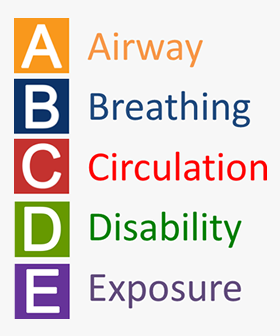
The RRAPID course runs throughout the University of Leeds undergraduate curriculum. The principles not only encompass managing acute illness but also encourage you to determine how the episode could have been prevented and the longer term management objectives. Paediatric RRAPID (pRRAPID) will build on the concepts from RRAPID1-3 and apply them to a paediatric population. pRRAPID will teach students how to Recognise and Respond to the acutely ill child. pRRAPID does not cover how to manage trauma to children.
The pRRAPID assessment of the acutely ill child revolves around the traditional ABCDE system based approach:

The authors of this book include frontline paediatricians and allied healthcare professionals. It has been created with the help of both undergraduate and post graduate trainees. The information included in this book is up to date with current clinical practice and national and local guidelines used in Leeds Teaching Hospitals. However, it is recommended that users outside of Leeds consult local protocols and guidelines. In all case specific drug doses should be checked in the British National Formulary (BNF) for Children.
Further information regarding the RRAPID course can be found at http://rrapid.leeds.ac.uk
Each section follows a similar structure:
Each of the ABCDE chapters begins with a clinical case scenario specific to the organ system. This is used to illustrate how the RRAPID approach should be applied in clinical practice. Questions are posed to test your ability to manage acutely ill patients.
A brief introduction to the relevant anatomy and physiology of each system is given, in particular how this differs from adults, where clinically relevant. This aids understanding of the causes of each system dysfunction which leads to patient deterioration.
For each system (ABCDE), there is a list of the different pathological processes causing system dysfunction. This will concentrate on the more common paediatric conditions and also cover some of the less common life threatening problems.
Recognising the acutely ill and deteriorating child is the essential first step. Paediatric patients will present in different ways but this section will describe the common symptoms and signs of deterioration within each system.
Simple but effective early interventions are described. These can be performed by junior medical staff, which at an early stage may significantly improve the child's outcome.
Each chapter ends with a brief summary box with key learning points.
Interactive cases and multiple choice questions are provided to test understanding of a topic.
The outcome for children who enter cardiac arrest is generally poor. Compensatory mechanisms in children are good, therefore once decompensation occurs; the situation is difficult to retrieve. Therefore it is important to understand and recognise the conditions that lead to children arresting, (see figure 1*) with hypoxia being the most common cause.
Recognising and responding to the sick child can prevent arrest occurring (chapter 3-7). If arrest were to occur then good BLS is required (chapter 2), and good BLS technique is the foundation on which more advanced resuscitation skills are built.